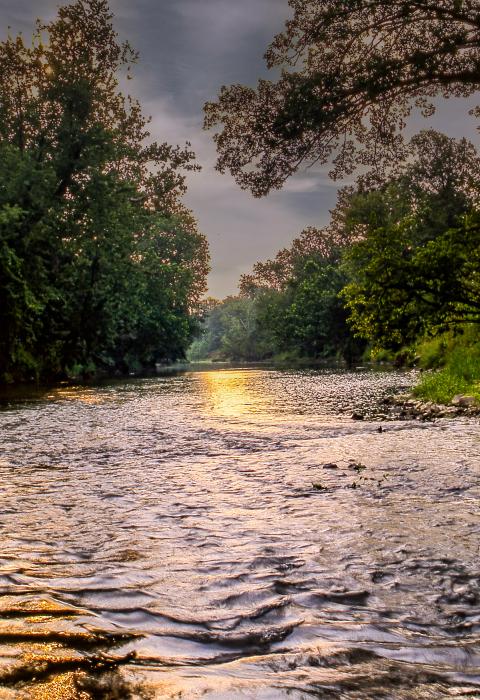Middle Fork Vermilion River
Illinois
The river meanders deeply through Illinois’ Grand Prairie glacial deposits, exposing scenic, steep valley slopes with high bluffs of geological note. The valley’s unique flora and fauna are highlighted in several adjacent natural areas and nature preserves, both forested and prairie, along with the river’s recreational and historical characteristics. The majority of the designated river segment is publicly owned with a wide variety of access opportunities.
Designated Reach
May 11, 1989. From river mile 46.9 near Collison downstream to river mile 29.8 at the Conrail Railroad crossing north of U.S. Highway 150.
Outstandingly Remarkable Values
Ecology
The river corridor provides for a variety of habitats. There are upland forest, forested wetlands, seeps, and hill prairies. Forests of the Middle Fork are typified by rich herbaceous communities with a number of uncommon species, which combine to make the community distinct from similar woodlands in other natural divisions. The prairie habitats in the river corridor are dominated by grasses representative of the midwestern prairie area contains Indian grass and tall gayfeather. At least 62 prairie plant species are found in the corridor. The seeps are highly calcareous and support a variety of notable plants.
Fish
Gamefish present in the Middle Fork of the Vermilion River include an excellent population of smallmouth bass, largemouth bass, spotted bass, channel catfish, a variety of sunfish species, and bluegill. The bluebreast darter is a state endangered species found only in the Middle Fork of the Vermilion River in Illinois. The dusky darter is only found in the Middle Fork and Embarras River basins in Illinois. Other rare fish found in the Middle Fork are the brindled madtom and river redhorse.
Geology
In general, the present land surface is a flat, hummocky plain broken occasionally by low morainal ridges. Stream channels in the headwaters are usually poorly developed. Only in the lower portions of the streams, where a large part of the erosional work was accomplished by melt water during the recession of the Wisconsinan glacier, are the valleys well developed and incised.
Recreation
As a recreational resource, the Middle Fork mainly serves to provide canoeing and fishing. The river receives only light fishing in its upper reaches, but fishing activity increases further downstream. The river is know for its excellent smallmouth bass fishing. Canoeing demand in the region is also high. The river corridor also includes access to three publicly owned areas—Kickapoo State Park, Middle Fork State Fish and Wildlife Area, and Kennekuk Cove County Park.
Scenery
The atmosphere on the river is quiet and serene throughout most of the corridor, most noises being the rushing water, birds, and occasional hikers or canoeists. This is due to the largely undeveloped shorelines.
The floodplains of the river are mostly old agricultural fields, forests, or forested wetlands. Some of the old fields are now revegetated with shrubs and perennial grasses. Most of the view from the river is of trees, bluffs, or open fields.
Wildlife
The river corridor is known for its species diversity. This is in part due to the variety of habitats, which include woodlands, grasslands, shrubs, and riparian. The river corridor serves as breeding habitat for several state threatened or endangered birds—pied-billed grebe, least bittern, northern harrier, Cooper’s hawk, long-eared owl, veery, and Henslow’s sparrow. The silvery salamander is only found within the river corridor in the state of Illinois. Other uncommon amphibians and reptiles include the eastern wood frog, two-lined salamander, red-backed salamander, slimy salamander, northern ringneck snake, queen snake, midland painted turtle, Blanding’s turtle, and map turtle.

